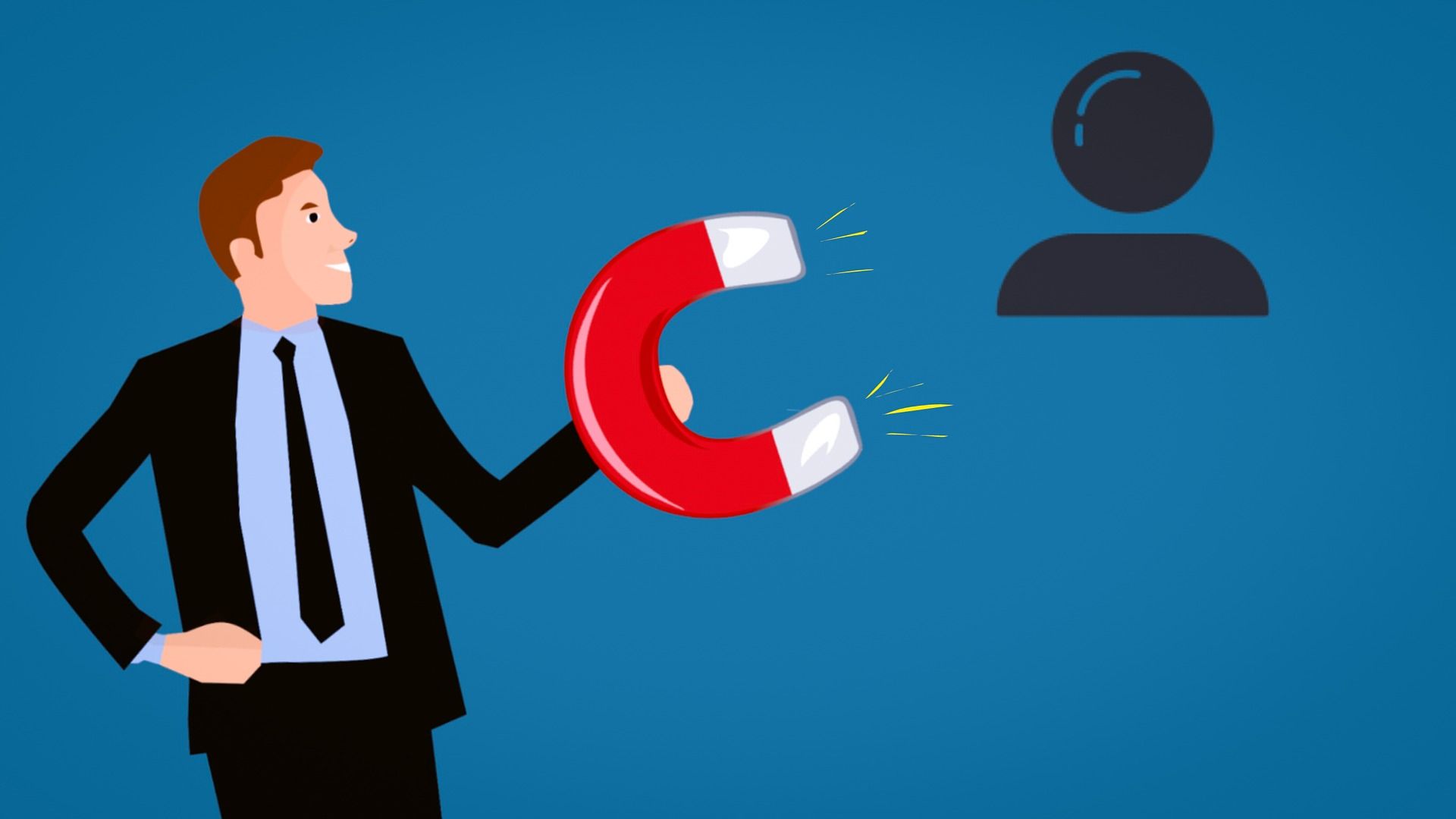Lead marketing is activities aimed at gaining contact with potential customers. These are people who are likely to show interest in a product or service and buy it. Acquiring leads should be one of the pillars of the work of the sales department and marketing department in the company. The more valuable leads, the larger the potential customer base.
What will you learn from the article?
Have you ever wondered what lead generation is and why it is so important for your business? In the world of marketing, generating leads is the key to success. But what exactly does 'lead' mean? What are the different types of leads and how can you generate them effectively?
In this article, we will discover the secrets of online lead marketing. You'll learn how to create the perfect landing page to grab the attention of potential customers, and how to effectively attract enquiries that will convert into valuable customers.
Ready to dive into the world of lead marketing and discover how to change your marketing strategy for the better? Let's get started!
Contents:
Lead marketing - definition
Lead marketing is an expression derived from the English language, which when translated into Polish means: lead generation marketing. In short, it's a process of acquiring potential customers and then converting them into buyers.
Lead marketing is a very important link in modern marketing. Online consumer behavior is constantly changing and evolving. People are looking for all kinds of information about the company, its products or services on the Internet. Only at the very end do they direct their questions to the sellers. That is why companies should pay special attention to their website, Facebook, Instagram, Google positioning. It is in these channels that customers first look for information about what interests them. Lead marketing is the answer to these consumer behavior. Its purpose is to communicate with potential customers depending on their stage in the purchasing process, and then respond to their needs.
Ruth Stevens in "Mazimizing Lead Generaion: The Complete Guide for B2B Marketers" emphasizes that lead marketing is "motivating, encouraging potential customers to be active, to be involved. " According to Stevens, it is the most important element of the entire business-to-business marketing, because it is the influx of potential consumers that enables the constant development of the company. The key to lead marketing is to attract the attention of potential customers and gain their trust. That is why many companies use several channels to make lead marketing effective.
What does lead marketing look like in practice? First, you need to attract the attention of your potential customers. How to do it? Through appropriate SEO activities, advertising in search engines, social media, banner advertising, online pr, or fairs and conferences. The next step is to contact interested persons and encourage them to leave their personal data. The collected data is used to prepare relevant marketing campaigns.
Lead marketing - quotes
According to the dictionary "At Internet" lead "refers to contact with a potential customer, also known as a prospectus. " It points out that the term lead for companies may have different meanings, however, the common thing is that "Lead can potentially become a future customer." David Scott explained in detail what a lead is in "The new rules of Lead Generation: proven strategies to maximize marketing ROI". We can read there that "leads are people who have been identified as candidates whose interest can potentially turn into sales (...). It signals the degree of interest in a given product or service and is identified as a real option that meets specific customer needs. "
An important element in lead marketing is the so-called inbound marketingwhich allows you to gain new contacts. How? Witczak in "Inbound marketing and the concept of relationship marketing" explains: "Inbound marketing is activities aimed at arousing interest in the company's offer among recipients who, while searching the Internet, reach information published by the company in the media and social networking sites. " A key component of the entire process is content creation, i.e. content. Thanks to this, the company will be highly positioned in search engines, and thus: more customers will reach the company's website.

The stages of lead marketing activities that lead to the acquisition of the so-called leads, were proposed by Bajdak in "Marketing automation - a technology that improves the work of the marketing department in a company":
- "in the first place, the system is responsible for generating traffic on the company's website,
- then for acquiring leads that are educated in an individualized way thanks to the constantly accumulated knowledge about them and classified.
- Ready-to-buy leads are then passed on to the sales department. "
What is lead acquisition?
Lead acquisition is a term that often comes up in discussions about marketing and sales activities. The term, although it sounds rather mysterious, is simply the direct outreach to potential customers (individual and business!) through various communication channels. To put it even more simply, acquiring leads = acquiring contact data. It is very important to approach the matter comprehensively. This means not resting on your laurels, but analysing and improving lead marketing on an ongoing basis. Lead acquisition is also referred to as lead generation, and the most valuable is generating sales leads.
The more valuable leads, the larger the potential customer base.
Check how we can help you.
The key thing in lead-based marketing is acquiring contacts, and more specifically - contact details for specific people or decision-makers in the company. There are several proven marketing methods that will shorten the path to a potential customer. However, it is important to realize that there are three types of leads, the acquisition of which may be the goal of activities called lead marketing.
What are the types of leads?
The division of leads has been introduced to facilitate the classification of customers into specific groups based on what the marketer / salesperson wants to get from him. It does not always have to be the mere purchase of a product or service. In long-term strategies, obtaining a sales lead, which is obviously the most valuable, is only the culmination of the process of reaching the customer. Before that, it is necessary to obtain a regular lead, i.e. a contact lead, and a lead marketing lead. But we explain this in our short characteristics. So the types of leads are:
- Lead - the simplest type of lead is simply contact information for a potential customer. The simplest lead is his name and surname and email address. The more of this data, the better. Therefore, information about the place of residence / staying, gender, age, interests, link to social profiles, etc. is also valuable. In English teminology it is called an information qualified lead (IQL), commonly referred to as a cold lead.
- Marketing lead - effective sales support and additional data about a potential customer that can be forwarded to the sales department. This information allows us, for example, to track what a potential customer saw on our website, what he or she stayed for longer, what interested him. His interest in our services or products gives us a signal that this person can be classified as an attractive marketing lead with the potential to become a sales lead. In English it is called a marketing qualified lead (MQL), and colloquially a warm lead. A marketing lead is also a person who voluntarily left their data in the form on the website, for example, marking marketing consents.
- Sales lead - in the industry jargon, it is called a hot lead; it is the most valuable contact from the point of view of our company's interests. Means a person who shows a high interest in buying a service or product, for example, by leaving his contact details. The task of the sales department at this point is to close the deal. In English, it is called a sales qualified lead (SQL).
How to generate leads?
Deadline lead marketing means acquiring leads through various marketing techniques, both as part of B2C campaigns and through B2B marketing. It is a difficult job as it aims to extract only valuable contacts that give a high chance of finalizing the conversion.
The following are used to generate leads:
- newsletter and email marketing,
- content marketing through blogs, infographics, video marketing,
- social media,
- link building and other methods of website positioning in the search engine (SEO),
- PPC campaigns, including Google Ads,
- traditional forms of advertising,
- telemarketing,
- event marketing.

Back in 2014, marketers surveyed by Chief Marketing indicated that email marketing is the most effective method of acquiring marketing and sales leads. Since that time lead marketing however, it has undergone major changes. He took the priority palm content marketing, i.e. generating leads by publishing attractive content - both on the company website, on the blog, in social channels, through sponsored articles in external media, as well as on video websites such as YouTube.
Are there other methods of acquiring leads?
Lead marketing it also uses a number of minor solutions, especially online marketing. In the last 2 years, web push notifications have gained popularity. It is obtaining the voluntary consent of users to receive notifications about new content published on the website. In addition, obtaining leads is done by sharing the so-called premium content. The user leaves his contact details in exchange for the possibility of downloading high-quality content, e.g. a report or an e-book. Social selling is also of great importance. This concept covers building relationships with potential customers through referral marketing in social media, as well as on websites such as LinkedIn or on internet forums.
What is online lead marketing
Online lead marketing activities involve obtaining the necessary contact details through various activities on the Internet. In order to obtain leads of interest to the sales department, you should create a special place on the Internet where potential customers will be able to leave their contact details. This is Landing Pages. A website that will allow the customer to decide whether he buys the product or uses the service right away, or whether he or she needs to be encouraged to buy in an appropriate way.
Creating Landing Pages is necessary and it is worth putting some effort into it. So, we present the most important points that should be on the page where the potential customer "lands". Regardless of whether the link to the website was obtained via social media, newsletter, or perhaps he found it while browsing the company's website.
How do you create the perfect landing page?
You can think about what a perfect landing page should look like for hours. It all depends on the specifics of the company and what goal the website is to help achieve. Is it supposed to get new newsletter recipients? Or should she sell the course? Do we want to gain new customers thanks to it? All of these goals determine the appearance of the landing page. The purpose of the landing page must be clearly stated. If we want different goals (acquiring newsletter recipients, selling a course online, selling a book, etc.), different landing pages should be created. In this way, the client will be able to focus on one specific activity that we care about.
Also, the length of the landing side depends on the goal we want to achieve with it. You can create a screen-sized landing page or one that needs to be scrolled. If you want to get newsletter readers, all you need is a contact form, thanks to which the recipient will leave their contact details. The new lead obtained in this way will not sell immediately, but will allow you to gain trust and relationships with a potential customer. When creating landing pages, it is worth considering the client's profile. The offer for an individual customer will look different than for a company. Therefore, a separate landing page should be created for different profiles of potential customers.
Once you know for whom and for what purpose your landing pages are created, it is worth paying attention to
what parts a good landing page consists of. First, it has to be safe.
That is why it is so important to take care of an SSL certificate. It is a locked padlock that you can see
next to the website address.
This element of the website, which not only inspires trust, but above all
it raises the prestige and credibility of the company for everyone. Nowadays, an SSL certificate is
must have of any website.

At the very top of the landing page, there should be key information - where the potential customer ended up and why he was here. We should clearly write what can be acquired on the site. Another important element of landing pages is call to action. These are usually buttons that allow the reader to perform a specific action. "Find out more", "Buy now" or "Subscribe to the newsletter" are just some of the possibilities.
References can speak for still undecided. To make them credible, you can ask customers to use their photos or, for example, logos of companies that have decided to cooperate. In addition, if the company can boast of various awards or certificates, it is also worth informing about it.
The simpler the better
The most important part of any landing page is the form to be filled out. The shorter the better. It is worth considering its appearance and discussing it with the marketing department. The fewer fields the client has to fill in, the better. The same applies to the consents that should be marked.
Once a potential customer trusts us and leaves a lead with his contact details, thank him. For this purpose, a thank you page is created, to which the customer will be redirected after sending the contact form. Remember to inform him about what will happen now. For example, "You will receive an order confirmation e-mail" or "We have sent you a confirmation e-mail address".
Find out more - read also:
When is marketing outsourcing the best solution?
What are public relations instruments and how to use them?
Storytelling - an example. How to build unique relationships?
Warming your image - take the right course
Real-time marketing - when rush is a good advisor
Lead marketing - what you should know:
What is lead marketing?
Simply put, it is a process that first involves acquiring potential customers and then converting them into buyers. Lead marketing is a response to customer behavior on the Internet.
What is lead acquisition?
Despite the mysterious sound, this term simply means directly reaching potential customers - both business and individual - through various communication channels. each new lead is new contact details of a potential customer. Lead generation is also known as lead generation.
What are the types of leads?
In order to facilitate the classification of customers into specific groups, a division of leads was introduced based on what a given marketer wants to achieve. The basic division is lead, marketing lead and sales lead.

